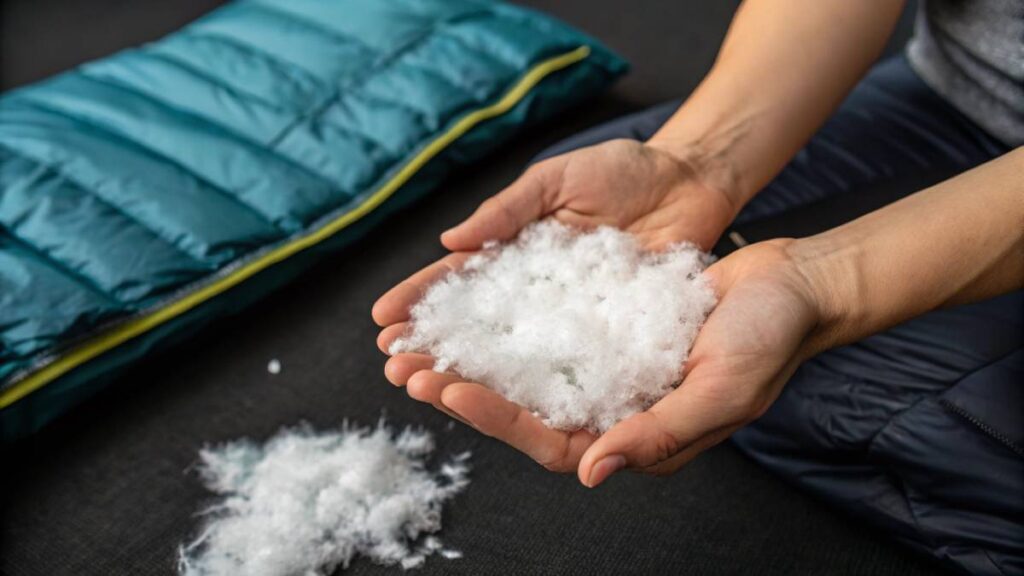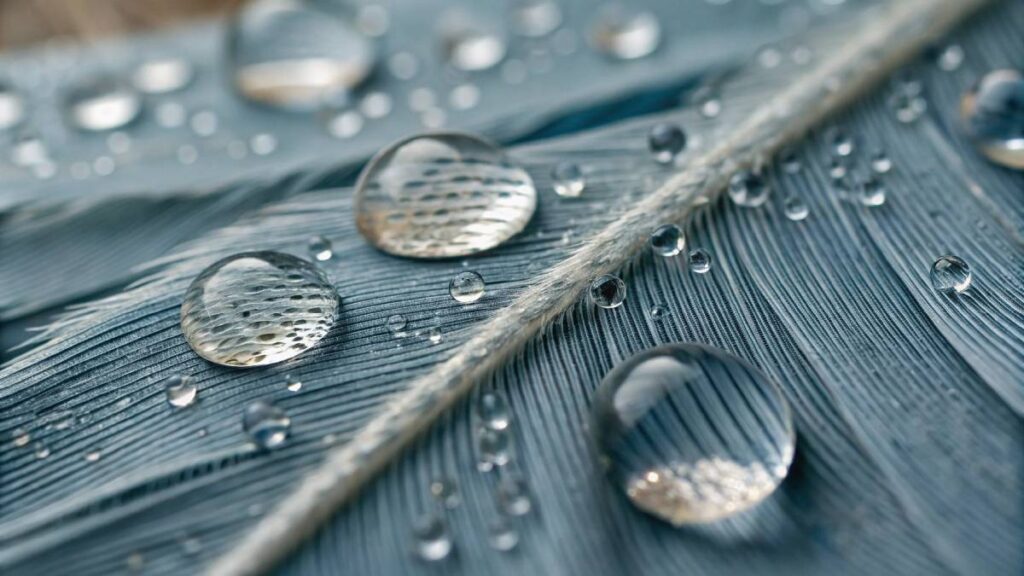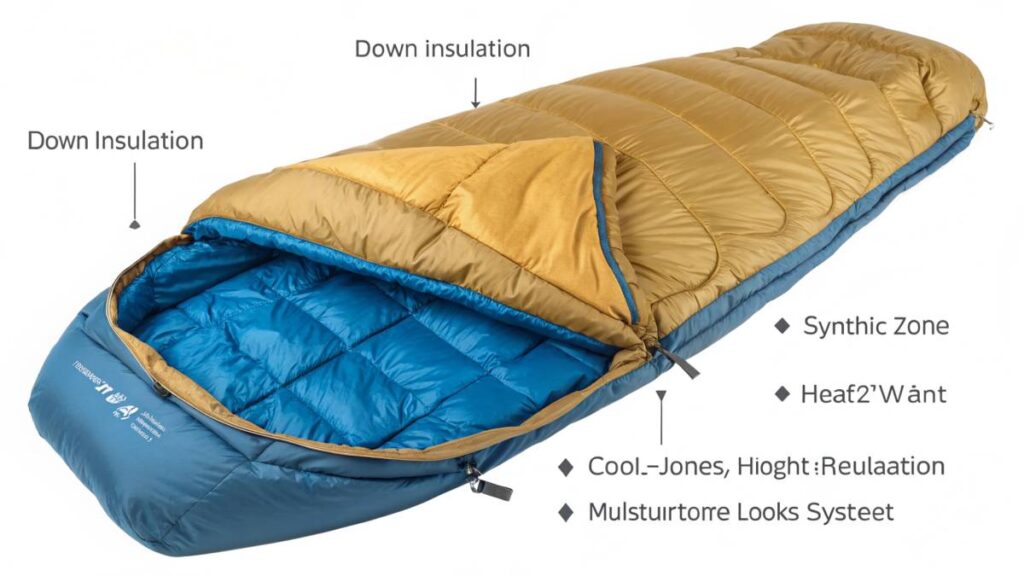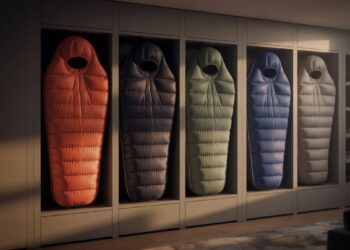Imagine unzipping your sleeping bag under a starlit sky, exhausted from a day’s hike, only to find yourself shivering through the night because you chose the wrong insulation. The battle between down and synthetic insulation isn’t just about comfort—it’s about survival, sustainability, and smart investment. Whether you’re an ultralight backpacker counting ounces or a weekend warrior braving unpredictable weather, understanding the nuances of sleeping bag insulation can transform your outdoor experience from merely enduring to truly enjoying nature’s embrace.
Key Takeaways
- Down insulation offers superior warmth-to-weight ratio, exceptional compressibility, and longevity when properly maintained
- Synthetic insulation excels in wet conditions, dries quickly, costs less, and performs reliably even when damp
- Fill power (ranging from 600-900+) determines down quality; higher numbers mean better insulation with less weight
- Hybrid options combine down’s warmth with synthetic’s moisture resistance for versatile performance
- Responsible Down Standard (RDS) certification ensures ethical sourcing of down products
- Down is a better long-term investment despite higher initial cost, potentially lasting decades with proper care
- Synthetic bags are more budget-friendly initially but typically only last 5-7 years before losing insulation properties
Understanding Down Insulation
When it comes to picking the right sleeping bag, understanding down insulation can be a game-changer for campers and outdoor folk alike. Here, we’ll break down why this fluffy stuff is so loved and why fill power matters.

Benefits of Down Insulation
Down insulation has got some perks that make it a go-to for the adventurers. Its assets aren’t just minor pluses; they’re what make a sleeping bag go from good to oh-so-cozy.
| Benefits | Description |
|---|---|
| Lightweight | Down insulation’s light as a feather, perfect for those who need to keep things light (ultralight backpackers, here you go). |
| Compressibility | You can squish down into a tiny bundle, freeing up precious backpack room. |
| Long-Lasting | Handle it with care, and down’s loft and warmth stick around for years to come (learn to clean a sleeping bag right). |
| Breathability | Down lets moisture out, keeping sleepers snug and dry. |
Fill Power and Its Importance
Fill power’s a measure of how well down fluffs up and traps heat. It’s all about figuring out how much space one ounce of down can fill in a tester. The bigger the number, the better it keeps you toasty.
| Fill Power (fp) | Cubic Inches Filled by One Ounce of Down |
|---|---|
| 600 fp | 600 cubic inches |
| 700 fp | 700 cubic inches |
| 800 fp | 800 cubic inches |
| 900 fp | 900 cubic inches |
High fill power means you need less of it to stay warm. This keeps the bag light and easy to pack. The top-of-the-line stuff, like premium goose down, can hit 900 fp or more. Duck down generally maxes out a bit lower, around 750 to 800 fp.
“The difference between an adventure and an ordeal often comes down to the quality of your sleeping bag insulation.” – Outdoor Survival Expert
Picking out a bag with the right fill power is all about the conditions you’re expecting. Higher fill powers suit cold, dry spots or for when traveling light is key. If you’re looking for versatility without breaking the bank, you might want to check out different types of sleeping bags to find what suits you.
For more on how different fills stack up in the great outdoors, have a look at our article about summer vs winter sleeping bags.
Exploring Synthetic Insulation
Getting into the wild with a comfy sleeping bag is a must for those into camping, hiking, or just exploring the backwoods. Synthetic insulation is a major player in this game, offering solid perks that make it a go-to for outdoorsy folks.

Advantages of Synthetic Insulation
Synthetic stuff generally comes from polyester fibers and brings some definite perks:
- Quick Drying Champ: Synthetic materials are like that friend who’s always ready; they dry off in a jiffy when wet. So, if you’re caught in a drizzle or dealing with morning dew, these sleeping bags are your best bet.
- Wet Weather Warrior: Take that, soggy weather! Even if the rain gods unleash their wrath, synthetic insulation keeps you toasty. If you’re facing a damp forecast, this is your ticket (REI says so, too).
- Easy on the Wallet: Who doesn’t love spending less dough? Synthetic sleeping bags usually cost less than those fluffy down options, making them budget-friendly for adventurers.
- Tough Cookie: Those fibers can take a punch – they’re hardy and can stand up to a bit of moisture and being squeezed into your pack.
- Allergy Alert: Some folks sneeze at the thought of down. If that’s you, synthetic insulation says, “Here’s a tissue-free cuddle.”
Types of Synthetic Insulation
Synthetic insulation comes in two flavors: short-staple and continuous filament, each with its unique vibe and perks.
Short-Staple Synthetic Insulation:
- These little fiber guys are short but might be closer to what down feels like, with a softer and bendy mix.
- They’re easy to pack but might show their age quicker than the continuous ones.
Continuous Filament Synthetic Insulation:
- Longer strands that kinda remind you of Rapunzel’s hair.
- Tougher and not easily squished, so they keep you warm reliably.
- They can be a bit thicker and hard to pack up compared to their short-staple siblings.
| Type of Insulation | Characteristics | Pros | Cons |
|---|---|---|---|
| Short-Staple Synthetic | Short strands of fiber | Softer, easy to pack | Less tough in long haul |
| Continuous Filament | Long, flowing strands of fiber | Durable, dependable warmth | A bit bulky, harder to compress |
Want more deets on how it holds up in different weather? Check out our guide on sleeping bag temperature ratings.
When you’re sizing up synthetic insulation, think about what matters to you—maybe you’re all about quick drying or just saving a few bucks. Whatever floats your boat, synthetic insulation’s got you covered for plenty of outdoor fun. For more advice about picking the right sleeping bag, see our articles on types of sleeping bags and summer vs. winter sleeping bag.
Down vs. Synthetic Performance
Choosing between down and synthetic sleeping bags can be like picking between marshmallows and chocolate for your s’mores. Each brings its own flavor to the campfire. The main focus should be on how they handle the wet stuff and how tough they are over time.

Comparison in Wet Conditions
When it rains, synthetic bags show their tough side. They’re mostly spun from polyester yarns and bravely keep you warm while shaking off the damp. No long drying time. You can throw a bucket of water on them, and they won’t even blink. On the flip side, down takes a dive when the weather gets soggy. It soaks up moisture like a sponge, losing its comfy puffiness, leaving you chilly (thanks for the tip, TrailGroove).
| Feature | Down | Synthetic |
|---|---|---|
| Warm While Wet | Nope | Yep |
| Dries Fast | Nope | Yep |
| Soaks Up Water | Like a sponge | Nah |
Synthetic bags become your best buddies when Mother Nature turns the shower knob. They outshine even the fanciest water-resistant down bags in swampy conditions (Therm-a-Rest).
Longevity and Durability
Synthetic gear tends to be the rugged adventurer in the great outdoors. They laugh in the face of rough terrains and rougher handling, bouncing back from being crammed into your pack for the nth time. They’re also hypoallergenic, making them friendly to everybody’s noses, even those fussy ones (REI).
On the other hand, down bags are like that friend who looks great but isn’t always up for sticking with you through rain or shine. They excel in lightness and compressibility but struggle with durability, especially as the rain pours down repeatedly (TrailGroove).
Planned a big hike? If weight on your back matters most, down wins the gold with its weight-to-warmth magic. But if you don’t wanna mess with finicky gear that can’t take getting drenched now and then, synthetic’s your go-to (TrailGroove).
| Feature | Down | Synthetic |
|---|---|---|
| Lasts Long | Middlin’ | Like a champ |
| Toughness | So-so if wet | Takes a lickin’ |
| Weight vs Warmth | Light as a feather | Heavier, but warm too |
Knowing these pros and cons helps campers, backpacking fanatics, and the outdoorsy types make the right sleeping bag call. Wanna explore the different kinds of sleeping bags further? Check out the rest of our guides for extra knowledge!
Hybrid Insulation Options
Let’s talk sleeping bags, specifically those nifty hybrid options that mix down and synthetic insulation. These babies are just the ticket for anyone who loves sleeping under the stars, whether you’re just the weekend camper type or a hardcore winter adventurer.

Benefits of Down/Synthetic Blends
Hybrid sleeping bags toss together the warmth and the fluffiness of down with the sturdy, water-resisting powers of synthetic stuffing. This combo means fewer drawbacks and more snuggle-worthy nights (according to experts at REI).
Key Benefits:
- Moisture? No Problem! Even when Mother Nature gets a bit soggy, your bag stays warm. That’s thanks to the secret superpower of moisture-busting synthetic insulation and reliable down.
- Packing Heat Without Bulk: Down is light as a feather (because it kind of is), and synthetic dries in a flash. It’s a killer combo for campers dealing with all sorts of weather and packing needs.
- Built to Last: Toss your bag around all you like. Synthetic stuff makes sure it’s up for a beating while down makes sure it stays puffed and cozy for the long haul.
- Always Ready for Action: From beachside bonfires to icy mountain treks, these hybrid bags have your back —and front. They’re a great pick for all kinds of camping escapades.
Placement of Insulation
Placement matters! Where the down and synthetic fillers go in your hybrid sleeping bag can make all the difference. Brands have figured out some smart ways to place the insulation, focusing on where each kind can do its best work.
Insulation Placement Strategies:
- Mixed Throughout: Some bags decide not to play favorites and mix down and synthetic all over. This strategy offers consistent warmth and keeps water at bay across the entire bag.
- Zoned Positioning: Other designs are more strategic:
- Down on Top: Keep the down up top where it can show off its warming talents, especially important when you’re losing heat to the chilly air.
- Synthetic on Bottom: Synthetic rules the base, shielding against damp ground and standing up to pressure spots like a champ.
Table: Hybrid Insulation Placement
| Feature | Description |
|---|---|
| Blended Throughout | Even mix of down and synthetic for balance everywhere in the sleeping bag. |
| Down on Top | Down cushioning on top keeps warmth where you need it most when snuggled in. |
| Synthetic on Bottom | Synthetic filler on the base stands firm against ground moisture and guards against wear and tear. |
Picking a hybrid sleeping bag means you get the best of both materials— warmth from down and durability from the synthetic bits. For more sleep gear insight, check out our guides on how to clean a sleeping bag and proper sleeping bag storage. Make sure your next camping kit includes one of these hybrid heroes!
Responsible Sourcing Practices
Adopting the RDS Standard
When you’re picking the perfect sleeping bag, be it down or synthetic, how they source their materials is key. Enter the Responsible Down Standard (RDS)—think of it as a seal of approval for critter-friendly and eco-polite feathers. This isn’t just a fancy stamp; it’s about making sure every feather comes from animals treated right.
So, how’s that magic happen? The RDS keeps a watchful eye over the whole shebang, from farm fields to your cozy camping cocoon. Companies that wave the RDS banner are shouting, “We care!” Brands like REI are all in, pledging all their sleeping bag fill follows these feel-good rules (REI).
| Brand | RDS-Compliant Products |
|---|---|
| REI Co-op | 100% |
| Patagonia | 100% |
| The North Face | 100% |
| Marmot | 100% |
Plus, RDS makes sure everyone plays fair with annual checks—no sneaky business allowed, such as live-plucking or stuffing too much feed into those poor birds.
When you opt for these warm, fluffy bags stamped with the RDS love, you’re not just snagging a super snug sleep buddy; you’re also backing up some good vibes for our feathered friends. If you’re curious about how to pack the perfect warm punch in your outdoor adventures, check out details in our insulation options.
All told, these big-name camping crew members donning the RDS badge are letting us know they’ve got a conscience. Whether you’re gearing up for a camping weekend or living that ultralight trail life, choosing RDS means you’re bunking responsibly. Need to know more about keeping your gear like new? Our guide on cleaning a sleeping bag has got your back.
Price and Value Considerations
Cost Factors
Picking a sleeping bag can feel a bit like a treasure hunt. A key thing many shoppers look at is the price tag. Usually, a synthetic bag won’t make your wallet cry as much as a down bag. That’s because synthetic stuff, like polyester, is cheaper to whip up. On the flip side, down, which comes from ducks and geese, needs more work and cash to make.
| Sleeping Bag Type | Average Cost |
|---|---|
| Down Sleeping Bag | $200 – $500 |
| Synthetic Sleeping Bag | $50 – $200 |
Long-Term Investment
While a synthetic bag might be easier on your bank account at first, its lifespan might leave you wishing you’d spent a bit more. Typically, they start losing their mojo after 5-7 years, becoming less warm and comfy over time. Imagine that old sweater with holes—it’s kinda like that.
But those fancy down bags, despite the sticker shock, might just be the better bet for the long haul. If you treat ’em right—give them a good wash and dry—down bags can very well last for years and years. Even with mother nature’s rain dance, new water-repellent tech helps keep ’em going strong.
For anyone who’s ever dawned their explorer hat in chilly weather, dropping a few extra bucks on a good down sleeping bag could be a win in the long game.
All said and done, when choosing between these two cozy cocoon options, weigh your piggy bank against how long you expect to use it. If you’re searching for a budget-friendly start, synthetic is your pal. But if you’re eyeing a long-term snooze mate, down’s a worthy sidekick.
Looking for more sleeping bag wisdom? Check out our guides to the best winter sleeping bags and best 3 season sleeping bags.
Weight and Packability
Picking that perfect sleeping bag is like finding your soulmate—weight and packability often tip the scales, especially if you’re an outdoorsy type who’s all about shedding some pounds from their backpack. So let’s dive right into it and have a friendly chat about weight-to-warmth ratio and compressibility.
Weight-to-Warmth Ratio
Digging into that whole weight-to-warmth thing, down insulation steals the spotlight. If you’re playing Sleeping Bag Survivor, you’ll want the down kind, thanks to its super sweet weight-to-warmth ratio. Down scores big on fill-power, which is fancy talk for fluffiness. More fluff equals more warmth without adding bulk.
| Insulation Type | Typical Fill Power | Weight – 30°F Bag |
|---|---|---|
| Goose Down | 600-900+ | ~2lbs |
| Duck Down | 500-800 | ~2.5lbs |
| Synthetic | N/A | ~3lbs |
- Goose down can soar to fill powers of 900 or even better (REI), perfect for the frost-loving folks out there dreaming of campfires and toasted marshmallows.
- Down sleeping bags are also a top pick for those trying to make their pack lighten up, thanks to their super cozy warming powers (Therm-a-Rest).
Compressibility in Packing
If compact gear is what gets you going, down sleeping bags are the superheroes you need. For trail-trekkers with ultralight goals, these bags squeeze down, leaving room for other essentials like snacks and more snacks.
- Down insulation, all feathery and fine, collapses into teeny tiny packages that can tuck away in the nooks of your bag (TrailGroove).
- Synthetic sleeping bags carry a bit more heft but shine when soggy, making them a fine choice for exploring wetter fields or for people still learning the camping ropes.
| Sleeping Bag Type | Compressed Volume (30°F) |
|---|---|
| Down | 6-8L |
| Synthetic | 12-15L |
So, if you’re hashing out what’ll keep you toasty without breaking your back, down sleeping bags are your jam. If you’re more of a fair-weather traveler or need something more waterproof-friendly, don’t overlook the synthetics. Looking for more tidbits on choosing between sunny strolls and snow-laden escapades? Peek at our stellar guides and lend an ear to our wisdom.
Water Resistance and Drying Capabilities
So, you’re eyeing a new sleeping bag, huh? Well, buckle up, ’cause we’ll dive into the soggy world of water resistance and drying capabilities between down and synthetic sleeping bags. These two features are your best friends—or worst enemies—when Mother Nature starts weeping.
“In the wilderness, your sleeping bag isn’t just comfort—it’s your lifeline against the elements. Choose wisely.” – Professional Mountain Guide
Performance in Wet Conditions
Down vs Synthetic, the age-old showdown. Down insulation is like that friend who’s amazing at warmth and travel packing but turns into a soggy mess in the rain. When wet, those fluffy down clusters huddle up, giving you the opposite of cozy. To combat this, many down sleeping bags get a raincoat of water-resistant coating or use a water-resistant shell, trying their darnedest to keep you toasty in the drizzle.
Now, meet its rugged cousin, synthetic insulation. This material doesn’t mind a dunk here and there and still keeps its warming charm. Perfect for casual campers and beginners, especially if you often camp where the skies don’t know how to hold it in—humid, rainy, whatever. Synthetic fibers snub absorbing water and continue their warm embrace, no matter the sogginess.
| Sleeping Bag Type | Insulation Power in Wetness |
|---|---|
| Down | Weak |
| Synthetic | Strong |
Drying Speed and Efficiency
Think about drying speed, kind of like if you care if your stuff can dry overnight. Down sleeping bags? Like watching paint dry—takes ages thanks to their sponge-like water-sopping ability. Not really what you want if you’re hopping from one campsite to another and can’t wait a hot second (literally) under the sun for it to dry out.
On the flip side, synthetic sleeping bags shrug off water, drying off faster than a hairdryer on high. Backpackers and hikers, particularly those caught in surprise rain showers or car campers, can rely on this speedy drying trait. The quick-dry power of synthetic bags simply means more fun and less shivering, even if overnight rains decide to play villain.
| Sleeping Bag Type | Drying Speed |
|---|---|
| Down | Like watching grass grow |
| Synthetic | Blink, and it’s dry |
In the grand scope of figuring out your ultimate sleeping buddy, knowing how differently down and synthetic bags handle water is a game-changer. Whether you care more about warmth in a backpacker’s breeze or need an all-weather companion, picking the right insulation can save your camping behind. Peek at our insights on best winter sleeping bags and best 3 season sleeping bags for more sleeping bag gossip.
Main Tips
- Always store your sleeping bag uncompressed in a large cotton or mesh storage sack
- Use a sleeping bag liner to extend the life of your bag and keep it cleaner
- For down bags, never store them wet and dry thoroughly after any exposure to moisture
- Consider a hybrid bag if you frequently camp in varied climate conditions
- Check the temperature rating against the actual conditions you’ll face, not just the season
- A quality sleeping pad is just as important as your bag for staying warm
- Follow manufacturer cleaning instructions precisely to maintain insulation performance
- Look for RDS certification if choosing down to ensure ethical sourcing
- Consider fill weight (total amount of insulation) along with fill power when comparing bags
- Test a bag’s fit before purchasing—too tight restricts loft, too loose creates cold spots
Conclusion
The choice between down and synthetic insulation ultimately comes down to understanding your own outdoor habits, preferences, and priorities. There’s no universal “best” option—only the best option for your specific needs. Consider where you’ll be camping, what seasons you’ll face, how much weight matters to you, and what your budget allows. Remember that many experienced adventurers eventually own multiple sleeping bags with different insulation types for various conditions.
For ultralight backpackers and those camping in dry, cold environments, down’s exceptional warmth-to-weight ratio and compressibility make it the superior choice despite the higher upfront cost. The longevity of a well-maintained down bag—often lasting 10-15 years—ultimately provides better value for serious outdoor enthusiasts.
Synthetic bags shine in unpredictable weather conditions where moisture is a constant companion. Their ability to maintain insulating properties when wet and quick-drying capabilities can be lifesaving in rainy or humid environments. For beginners, budget-conscious campers, or those with ethical concerns about animal products, synthetic options offer reliable performance without breaking the bank.
Hybrid designs represent the cutting edge of sleeping bag technology, strategically placing insulation types where they perform best. These innovative options bridge the gap between the two worlds, offering a compelling compromise for those who camp across varied conditions throughout the year.
Whether you choose the plush warmth of responsibly-sourced down or the reliable performance of synthetic, the most important factor is that your choice enables you to sleep comfortably in the great outdoors, waking refreshed and ready for whatever adventures await.
FAQs
Why does down insulation lose its warmth when wet?
Down clusters work by trapping air in thousands of tiny pockets, creating an insulating barrier. When down gets wet, these clusters clump together, eliminating those air pockets and collapsing the loft that provides warmth. Unlike synthetic materials, natural down has no inherent water-resistant properties, making it essentially useless as insulation once saturated until it can be properly dried.
How much longer does down insulation last compared to synthetic?
With proper care, down insulation can last 2-3 times longer than synthetic options. While synthetic sleeping bags typically begin to lose significant insulating properties after 5-7 years of regular use, quality down bags can maintain their performance for 10-15 years or even longer. This longevity makes down a better long-term investment despite its higher initial cost.
What does fill power actually measure in down insulation?
Fill power specifically measures the volume (in cubic inches) that one ounce of down fills when allowed to reach its maximum loft under standardized testing conditions. A higher fill power (800+) indicates that the down clusters are larger and more mature, creating more loft with less weight. This translates directly to better insulation efficiency and improved warmth-to-weight ratio.
Are all down sleeping bags bad for wet conditions?
Not necessarily. Modern technology has created hydrophobic or water-resistant down treatments that help maintain loft and performance even when exposed to moisture. While these treatments don’t make down equal to synthetic in truly wet conditions, they significantly improve performance in damp environments and offer much faster drying times than untreated down.
What is the best insulation choice for beginners?
Synthetic insulation is generally the better choice for beginners due to its forgiving nature, lower cost, and easier maintenance. It performs reliably in varied conditions, requires less specialized care, and allows new outdoor enthusiasts to learn proper camping techniques without risking damage to an expensive down bag. As skills and experience develop, many outdoors people eventually upgrade to down for specific applications.
Resources
- REI Expert Advice: How to Choose Sleeping Bags
- Outdoor Gear Lab: Down vs. Synthetic Insulation
- Leave No Trace: Responsible Camping Guidelines
- Textile Exchange: Responsible Down Standard
Final Thoughts
The choice between down and synthetic insulation ultimately comes down to understanding your own outdoor habits, preferences, and priorities. There’s no universal “best” option—only the best option for your specific needs. Consider where you’ll be camping, what seasons you’ll face, how much weight matters to you, and what your budget allows. Remember that many experienced adventurers eventually own multiple sleeping bags with different insulation types for various conditions. Whether you choose the plush warmth of responsibly-sourced down or the reliable performance of synthetic, the most important factor is that your choice enables you to sleep comfortably in the great outdoors, waking refreshed and ready for whatever adventures await.
Recommended Products and Accessories
- Premium Down Sleeping Bag
- REI Co-op Magma 15 Sleeping Bag – Experience the ultimate warmth-to-weight ratio with this 850-fill goose down bag that’s perfect for serious backpackers. Get yours today for improved sleep on the trail!
- Budget-Friendly Synthetic Option
- Kelty Cosmic Synthetic 20 Sleeping Bag – Stay warm and dry without breaking the bank! This reliable synthetic bag performs impressively in damp conditions. Click to see current pricing!
- Hybrid Insulation Sleeping Bag
- Big Agnes Anvil Horn 15 Sleeping Bag – Can’t decide? This innovative hybrid design offers down on top and synthetic on bottom for the best of both worlds. Order now for versatile comfort!
- Sleeping Bag Liner
- Sea to Summit Thermolite Reactor Liner – Add up to 15°F of warmth and extend your bag’s life with this lightweight liner. Essential for maximizing your sleeping bag’s performance!
- Water-Repellent Down Treatment
- Nikwax Down Proof – Restore and enhance the water-resistance of your down bag with this specialized treatment. Keep your down performing at its best!
- Compression Sack
- Sea to Summit Ultra-Sil Compression Sack – Reduce your down bag to its smallest possible size without damaging the insulation. Perfect for backpackers looking to save space!
- Large Storage Sack
- REI Co-op Stuff Sack – Protect your investment by storing your sleeping bag uncompressed in this breathable cotton storage sack. Your bag will thank you with years of performance!
- Sleeping Pad
- Therm-a-Rest NeoAir XLite Sleeping Pad – Even the best sleeping bag needs a quality pad! This ultralight option provides excellent insulation from the cold ground. Complete your sleep system today!








